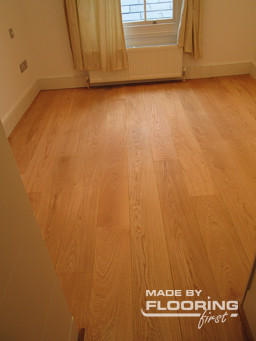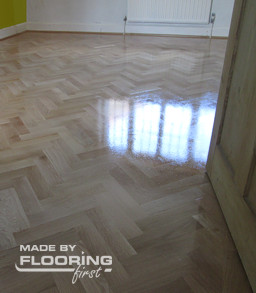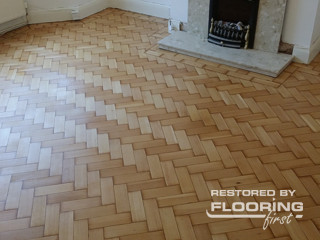Looking for a Floor Sanding Company in Wimbledon?
Transform your floors with our expert sanding, restoration, and repair services in Wimbledon. With a wealth of industry experience, our skilled and insured technicians specialise in rejuvenating all types of flooring, from parquet and pine to hardwood and engineered boards. We utilise dustless sanding equipment for a seamless and mess-free process, delivering not only beautiful results but also peace of mind. Our commitment to quality is evident in our use of top-tier sealants from Bona, Loba, Junckers and Osmo, ensuring a durable and flawless finish. Trusted by homeowners and businesses alike, we take pride in offering affordable, reliable services tailored to your specific requirements. At the core of our work is a passion for wood and a dedication to excellence, ensuring each project reflects our unwavering commitment to enhancing your floors and your space.
Discover More Wood Flooring Services We Deliver in Wimbledon:

- Solid wood, engineered wood, and parquet floor sanding and refinishing.
- Wood floor repairs, including spot refitting and floorboards replacing, water damage repairs, nailing and glueing down loose boards, and much more dedicated to the improvement of all types of real wood floors.
- Gap filling and improving the insulation of the floor.
- Wood floor staining along with a very impressive range of wood floor dyes and stains we supply and additional samples we provide to help you make the best decision.
- Soundproofing of wood floors.
- Supply and installation of reclaimed pine wood floorboards, reclaimed parquet flooring blocks, and original reclaimed wood flooring.
- Supply of all grades of solid wood, engineered wood, and parquet flooring.
- Supply and installation of flooring accessories.
- Get an EXTRA 10% discount on our clean & polish service for all floors previously fitted or restored by FlooringFirst! Services.
When working with us, you will get more than your usual wood flooring service. We strive to achieve the best results possible because we have a real passion for real wood flooring. We have a tailored approach to each floor and recommend only the necessary services.
Dust-free floor sanding and restoration services in Wimbledon
We pride ourselves in delivering the best quality and high standard wood floor sanding, repair, restoration, and maintenance services. As a company with years of experience in the field and a rich portfolio of thousands of successful projects, we are glad to be able to work with clients throughout Wimbledon. We believe everyone will appreciate and enjoy the minimal disruption, highly efficient wood floor services we deliver and you will be impressed by the results achieved.
No matter if it comes to a commercial or domestic wood floor project, we have the best set of skills to take proper care of all types of real wood floors. It is our mission to restore the original beauty, durability, and lasting power of your favourite solid wood, engineered wood, and parquet floor and minimise the potential risks of it getting damaged over time.
What to Expect from Our Wood Floor Sanding in Wimbledon?
When hiring our wood floor sanding team for your Wimbledon project, you can expect professionalism and a really high standard of work. It is our goal to not only provide all clients with the right approach to their flooring and ensure the best results possible but also guarantee minimal disruption and no stress and mess with every service.
A wood floor sanding service delivered by us starts with a free inspection of the floor and a free quotation. This is our way to make sure you are getting only the necessary services for improving your floor and you are not over-paying for something you really don’t need. Additionally, our wood flooring specialists will be glad to further provide you with advice and tips on better wood floor maintenance and the best products you can use for looking after your flooring.
Hiring our experienced and dedicated wood floor sanding team in Wimbledon means you will experience the best quality of service along with attention to detail and honest communication. Additionally, our customer service team strives to be as helpful as possible, available seven days a week and gladly responding to all your questions and concerns in order to always find the best solution. All wood floor services provided by the company are covered by a Floor Service Guarantee and comprehensive Public and Treatment Risk Insurance.
Take advantage of our floor repair services in Wimbledon

There are a lot of things that can happen to a real wood floor that can result in minor damage or major imperfection. So whenever you feel like your wooden floor is too damaged and it deserves a second chance, our floor repair team in Wimbledon is here for you to take care of your favourite flooring and breathe new life.
Our floor repair team is trained in all time-proven and advanced methods and techniques for taking care of hardwood, engineered wood floors and parquetry. Thanks to our experience and the knowledge we have gained throughout the years, we can always find and pick the right solution and approach each damage and imperfection the right way so we can ensure the best results.
Our floor repair team in Wimbledon will skillfully restore and renovate every wooden floor. We take care of a wide range of wood floor damages and issues including scratches, dents, gaps, marks, stains, loose, damaged or broken floorboards, unfixed nails and screws, cupping and ballooning of the floorboards and other issues that are results of the contraction and expansion of the floorboards due to increased moisture and humidity indoor levels. We also take care of the subfloor, making sure the floor installed on top of it will last forever, look perfect, and be in perfect condition.
With a comprehensive portfolio of hundreds of successful projects, our floor repair company is your best choice in Wimbledon. We don't just provide you with a professional service and make sure we are achieving the best results possible for you. We also guarantee a high level of customer care, professionalism, attention to details, dedication, commitment to success.
We believe that every floor repair project in Wimbledon is specific and requires a tailored approach. We will inspect the condition of your floor for free in order to make sure that only the most necessary steps are taken for completely restoring your favourite wooden floor back to its initial beauty, glory, and perfect condition.
Choose our parquet restoration services in Wimbledon

Parquet restoration is considered one of the most challenging services offered by a professional wood floor renovation and sanding company. It is because of the specifics of the parquet patterns that cannot be sanded straightforward, otherwise, the sanding machine will work against the grain of the wooden floorboards and this can damage wood permanently.
Therefore, parquet floor restoration requires a lot of attention to detail, knowledge and experience. Our parquet restoration team in Wimbledon works with a wide range of modern and advanced equipment and machinery in order to take care of all details and ensure the floor is perfectly sanded without missing a single spot or corner. Once the surface of the parquet pattern is absolutely smooth and there are no imperfections left, our parquet restoration team will use high-quality finishing and maintenance products to make sure all perfect results achieved will last for a very long time.
By choosing to work with us you are getting not simply a high-quality parquet restoration service. You are getting the comfort of a professional service that causes minimal disruption, minimises the mess and stress for you, and ensures the best results and all that at a reasonable price.
Our parquet restoration services in Wimbledon are covered with years of experience, craftsmanship, commitment to success, expertise and knowledge. The services we offer are suitable for both domestic and commercial floors and projects. We tailor every service to the specific requirements of the project and our clients. For both domestic and commercial parquet restoration services we are flexible, working also outside business hours and during the weekends.
Finishes available with our floor restoration services in Wimbledon
Our commitment to excellence is reflected in the premium finishes we utilise to bring out the natural beauty of your wood floors. Whether it's a comprehensive floor restoration project or a simple refinishing job in Wimbledon, we have the expertise and the right products to ensure stunning results.
Our selection of finishes includes the renowned "Bona Mega" lacquer, a quick-drying, water-based option that's perfect for both domestic and light commercial use. Available in a variety of finishes, including extra-matt, matt, satin, or gloss, it caters to various preferences and styles. For areas with heavy foot traffic, we rely on the durable "Bona Traffic HD" lacquer, providing extra protection and is available with an anti-slip option for safety in commercial settings.
In addition to the Bona range, we also offer products from Junckers, such as the "MT500 Floor Lacquer" and "HT700 Floor Lacquer" known for their quick-drying properties and extra durable finishes, making them ideal for commercial-grade applications. Our selection of primers, including "Bona Classic Primer" and "Bona Amber Primer" are designed to enhance the natural characteristics of the wood while ensuring durability and fast drying times.
To achieve optimal results, we utilise primers like "Junckers SB Primer" and "Junckers WB Primer" which not only enhance adhesion but also elevate the appearance of light-coloured wood floors, ensuring a flawless finish. For exceptional durability and wear resistance, our range includes the "Loba WS Fusion 2K Lacquer" a two-component, waterborne finish suitable for various flooring types, providing lasting protection and beauty.
Our expert floor sanding services in Wimbledon showcase unparalleled craftsmanship, bringing a breathtaking and enduring transformation to your home or business. Dial 020 88309782 to schedule your floor sanding today.
What Our Clients from Wimbledon Say About Us
“Everything went to plan. They both worked very hard and skillufully.”
Mr. J. Warson, from Wimbledon, SW19
“
George has been brilliant. The floor looks amazing. The office has been very helpful, too, about the alarm repairs. So many thanks. We are happy customers!
”
Mr. C. Gallannaugh, from Wimbledon, SW19
“
The guys were great, very polite and courteous, and the floor looks amazing. So thank you for doing such a great job.
”
Mrs. L. McDonough, from Wimbledon, SW20
“
Good service. Thanks.
”
Mrs. K. Collins, from Wimbledon, SW20
“
I am happy with work carried out. Contractor is great to work with.
”
Mr. J. Amamoo, from Wimbledon, SW20 8LB
“Great quick work. Finished to a high standard.”
Mr. Ben Henry, from Wimbledon, SW20 8EG
Floor Care Tips and Advice:
Find Our More on Sanding in Wimbledon
Local Project: Engineered Oak Flooring - Restoration And Staining Service in Wimbledon
When we arrived at the address, we found an engineered floor with a slightly worn finish. Parts of that finish were completely gone, revealing the bare, exposed wood below. The reasons for this could be many. For example, bad cleaning regime, moving of furniture, attempts to remove persistent stains and so on.
Sometimes people call us and ask, “Can you just sand this area and leave the rest of the floor untouched because it is not damaged?” The answer, unfortunately, is “No.” You see, if we only sand the damaged parts, this will lead to a colour disparity between the new finish we apply on the damaged areas and the old one. For this very reason, if you sand your floor, you strip all of it or none at all!
In the end, we had to sand the surface of an engineered floor which only needed a quick face lifting in order to reveal its beauty. It had not suffered any notable kind of damage … yet. The client was wise to call us before any real harm could occur. This is how you save money and prevent trouble in the future – you take care of the problem before it becomes a real threat.
Restoration Of The Floor
The biggest disadvantage of engineered floors lies in the fact that they can only be refinished a limited number of times. The reason is the thin real wood veneer sitting on top. Once this top layer is stripped to a certain point, there is no way to sand without revealing the plywood below. Fortunately, there was absolutely no problem restoring the surface of the floor. The veneer was in relatively good condition and we could proceed with the restoration without any worry.
Now, staining a floor can be difficult because different types of wood can react differently. There are those species which simply have a hard time absorbing the product because of their cell structure (birch and maple). Other types of wood have a natural colour which alters the shade achieved with the stain (red oak). The best way to see how the stain will look is by seeing it on your floor. That's why we provide free samples on the finishing products. Of course, the stain samples will be sanded away later on.
Then there is also the choice of finish. An oil or hardwax won’t work with lighter stains because they tend to turn yellow as they age. This means, that you need a lacquer, a water-based varnish which will keep the colours consistent. While darker stains don’t suffer as much from this, they are also affected. Some customers enjoy those effects, others do not and that is why it is important to hire someone who listens to what you want to do with the floor. Someone like us.
We easily sanded the surface with a fine sandpaper, filled the gaps and buffed everything one final time in preparation for the staining. The stain application itself must be performed fast and if you put too much of the product you risk the so-called “bleedback” when the excess material simply wicks back to the surface and destroys the uniform appearance of the floor. Naturally, we had no such problems. All that was left to do was apply multiple coats of Junckers HP Commercial and let it dry in peace. All done!
The Results
The whole job took us three to four days to completely mostly because staining the floor obviously increased the drying time. Four coats of Junckers HP Commercial were all it took to transform this worn and distressed floor into the beautiful surface you see below on the pictures. It was not a complicated job and our team enjoyed doing it. Our company provides its clients with the same excellent results regardless of the size and importance of the project. We value all of our customers equally and we can perform the same service on your floor for a very affordable price!
Local Project: Floorboards Sanding, Staining and Varnishing in Wimbledon
Wood floors are pretty resilient and resistant to a lot of things, they are able to resist neglect for a long time and even harsh treatment. Chances are, even after years of neglect and no in-depth maintenance, your wooden floor will still be at the point where it can be restored back to its initial perfect condition and appearance. However, chances are that years of neglect will result in your floor being in need of serious repair and renovation that can cost a lot and take some time. Therefore, it is always recommended to ensure proper and regular upkeep for your favourite floorboards and rely on professional and experienced help just like our customers did with their project. Part of the proper wood flooring maintenance is wood floor sanding and refinishing. Both treatments are the reason that real wood flooring can look as flawless as it has been just installed even after years of wear and tear.
We have started this project by inspecting the condition of the floorboards first. This is a mandatory part of the service provided by every reliable and experienced wood floor service provider. In general, it is recommended to have the floor re-sanded and refinished only when it is in perfect condition and no repairs are required. We supply flooring materials from world-renowned manufacturers and provide a wide variety of design options, which means we are able to find the perfect match that will blend smoothly with the existing floor.
Next, all gaps between the floorboards are filled in for the achievement of better structural integrity and improved insulation. While resin and wood dust are enough to fill in the smaller gaps, pine slivers are used for the larger and wider ones. Once all these repair processes are performed, the project can continue with sanding the floor. Wood floor sanding strips off the old finish from the surface of the floor along with all signs of wear and all imperfections. After that, we can continue with the application of a high-quality finish. Our clients picked a lacquer finish that adds a lot of elegance and beauty to the final appearance while ensuring long-lasting protection.